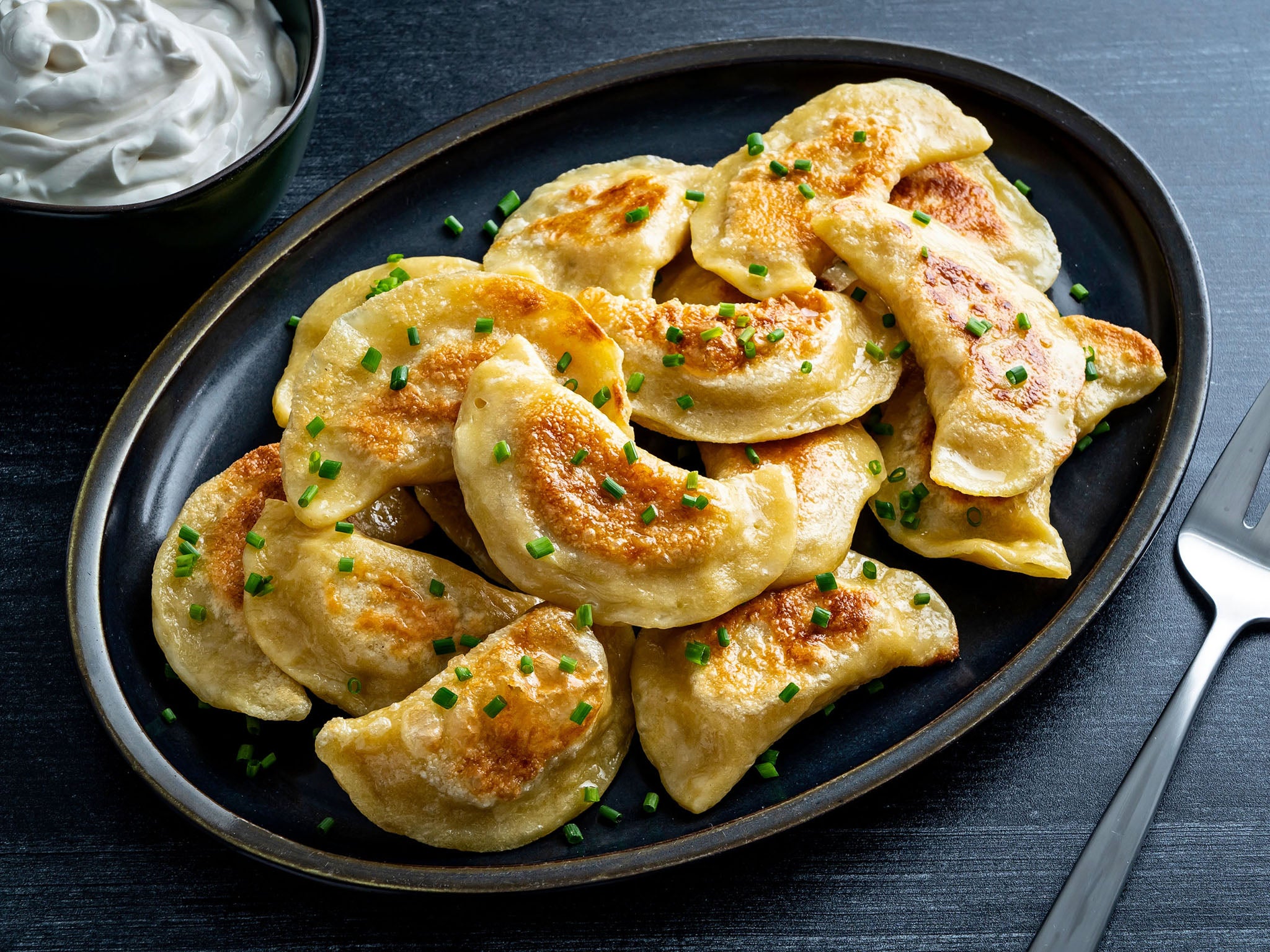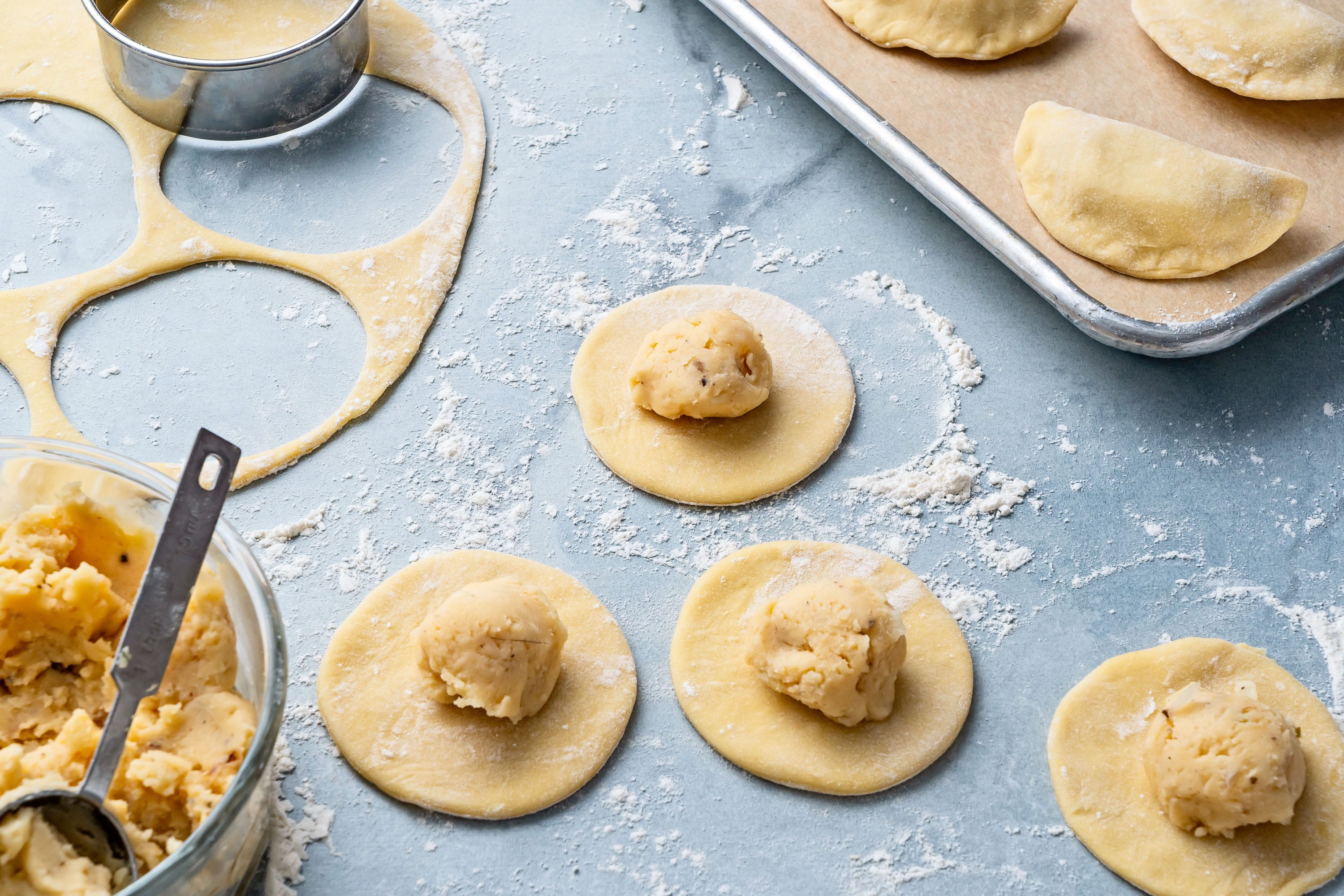In times of crisis, I turn to my grandmother’s Ukrainian pierogi
Jim Webster digs out his Ukrainian grandmother’s cookbook to make a connection with a place and a people he never knew he needed

Your support helps us to tell the story
From reproductive rights to climate change to Big Tech, The Independent is on the ground when the story is developing. Whether it's investigating the financials of Elon Musk's pro-Trump PAC or producing our latest documentary, 'The A Word', which shines a light on the American women fighting for reproductive rights, we know how important it is to parse out the facts from the messaging.
At such a critical moment in US history, we need reporters on the ground. Your donation allows us to keep sending journalists to speak to both sides of the story.
The Independent is trusted by Americans across the entire political spectrum. And unlike many other quality news outlets, we choose not to lock Americans out of our reporting and analysis with paywalls. We believe quality journalism should be available to everyone, paid for by those who can afford it.
Your support makes all the difference.When it all gets to be too much and I feel like I need to do something even when there is absolutely nothing I can do, I generally make my way to the kitchen.
Sometimes it results in a pie, or an over-the-top dinner for friends. For the past couple of years, it has mostly involved stress-baking bagels. I got pretty good at it, and it was a welcomed weekly distraction from pandemic monotony.
The situation in Ukraine has stirred up a new level of anxiety. Or, rather, reintroduced the anxiety that I grew up with as a member of Gen X. In high school in the 1980s, I was required to take a class called “Americanism vs Communism”. The formative pop culture of my youth included plot lines that involved surviving in a post-apocalyptic world or rogue teens saving the country from evil invaders.
It had been a nice couple of decades since we had to seriously worry about that dystopian narrative, but here we are again. And there’s really nothing I can do about it. So I’m heading to the kitchen.
I don’t align strongly with any particular ethnicity, but I remember when I was growing up, anytime we had a family get-together on my mother’s side, we would get to see my great-grandfather, Gigi, who I thought was fascinating with his thick accent and tales of “the old country.” It would be years before I learned that the old country he spoke of was Ukraine, and even then I wasn’t sure what that meant, because at the time it was part of the Soviet Union. I guessed that Ukraine was a state there, kind of like Pennsylvania, where we lived at the time. And I recently learned that he came to America sometime after the turn of the century as a stowaway on a boat, escaping the upheaval that was growing ahead of the Russian Revolution.
It had been a nice couple of decades since we had to seriously worry about that dystopian narrative, but here we are again. And there’s really nothing I can do about it. So I’m heading to the kitchen
The thing I remember most vividly from those parties was the food. There were always stuffed cabbages, which my grandmother made and I liked so much because they made me feel like I liked a vegetable. There were huge vats of kielbasa and sauerkraut. Beets with horseradish was one of my absolute favourites, a condiment I would put on everything in sight.
But the dish that got me put on the buffet watch list was pierogi. My grandmother, Nastazia, made those, too. They were mashed potatoes and cheese stuffed in a pasta dumpling wrapper, and they spoke straight to the heart and gut of the carbotarian I would become.
On the buffet, they would be served simply boiled and tossed with onions sauteed in tons of butter. There was always sour cream on the side, which just made them that much better. I was always near the front of the line, petrified they would run out before I got my turn. I ate so many once that I got sick, and restrictions were subsequently placed on my access to them. I felt like that was unfair, but every now and then I would manage to sneak a couple beyond my quota.
Other times when we had them, they would be boiled first, then pan fried, giving the already perfect package extra textural interest. I don’t prefer one way over the other. They’re both my favourite.
I wish I had paid more attention to the stories, or asked more about them when there was still someone to ask. I wish I knew enough to be able to match current events with things Gigi used to talk about, even though it would break my heart. Or maybe because it would break my heart, that very particular pain of having a deep enough connection to a place to feel innately the horror of what’s happening there.
But I do have the recipes. My grandmother wrote a spiral-bound cookbook of family recipes, and the last chapter is dedicated to Ukrainian dishes. The last time I made her pierogi, I did it because I was working through the fact that she didn’t have long to live, and I felt like making her recipe would be the connection I needed in the moment.
Now I’m making them for a connection to a place I’ve never been and ancestors I know almost nothing about. But also, maybe, to some living, distant cousin that has a place on a far-flung branch of my family tree. So distant that no online DNA sample would ever link us. Maybe they are going through something right now that I can’t imagine, being asked to defend their very home. Or to evacuate it. Maybe, if this wasn’t happening, I never would’ve wondered if they were out there at all.
Maybe I would have almost nothing in common with them. But maybe, just maybe, our recipes for pierogi come from a common root.

Ukrainian pierogi
Serves: 10 (makes about 30)
Active time: 1 hour 45 minutes | Total time: 2 hours
Dumplings stuffed with potato and cheese are beloved throughout central and eastern Europe, and in Ukraine may also be known as vareniki. Recipes for them are often scaled to feed a crowd, but the assembled, uncooked dumplings freeze well, and can then be cooked quickly for a hearty side dish. Serve 2 or 3 as a starter or side, or add a few more as a filling main.
Storage notes: Refrigerate cooked pierogi for up to 3 days. To freeze uncooked pierogi, transfer them to a baking tray, making sure they are not touching, and freeze them. Once frozen, place them into freezer containers and freeze for up to 3 months.
Ingredients:
For the filling:
680g russet potatoes or Yukon Gold potatoes, peeled and cut in 1.5cm dice
2 tbsp unsalted butter
1 small yellow onion (142g), finely chopped
113g sharp cheddar cheese, shredded
½ tsp fine salt
1 tsp freshly ground black pepper
Chopped fresh chives, dill or spring onions, for garnish (optional)
For the dough:
240ml warm water
2 large eggs, at room temperature
3 tbsp sour cream, plus more for serving
1 tsp fine salt
375g all-purpose flour, plus more as needed
Method:
Make the filling: bring a large pot of water to a boil over medium-high heat. Add the potatoes and cook until soft and the cubes can be easily smashed with a fork, 12 to 15 minutes.
Meanwhile, in a medium frying pan over medium heat, melt the butter. Add the onion and cook, stirring until just softened and beginning to turn translucent, about 4 minutes.
When the potatoes are cooked, drain and return them to the pot. Use a potato masher or a sturdy wooden spoon to mash the potatoes until fairly smooth. Add the sauteed onions and any butter still in the pan, plus the cheese, salt and pepper. Continue to mash the mixture until the potatoes are quite smooth and everything is well incorporated. Set aside to cool while you make the dough.
Make the dough: in a medium bowl, mix together the water, eggs, sour cream and salt. Put the flour in a large bowl and create a well in the center. Add the egg mixture to the well and, using a fork, begin mixing the liquid into the flour a little at a time until all the flour has been incorporated.
Lightly flour your work surface and turn the dough out onto it. Generously flour your hands and knead until the dough is soft and pliable, about 5 minutes. Let the dough rest for about 15 minutes.
Assemble the pierogi: line a large, rimmed baking tray with parchment paper and dust the paper with flour.
Generously flour your work surface and rolling pin. Working with about half the dough at a time, roll the dough out to about ⅓cm thick. Using a 7½cm round cookie cutter, cut as many circles from the dough as you can (you can gather the scraps and reroll it several times to make more).
On the centre of each dough circle, add about 1 tablespoon of the potato filling. Pick up the dough, fold it over the filling and begin carefully pinching the edges of the dough closed around the filling. It might look like there’s too much filling to enclose, but the dough will be very soft and pliable, and should easily stretch to close. Place the pierogi on the prepared baking tray, then fill and close the rest of the circles. Repeat with the remaining dough and filling (the pierogi can be frozen at this point; see storage).
To finish, bring a large pot of well-salted water to a boil. Drop the pierogi in a few at a time, so as not to crowd the pot, gently stirring them so they don’t stick together. Cook until they begin to bob to the surface, about 4 minutes. Remove with a slotted spoon, transfer to a platter and repeat as necessary.
Serve the pierogi with sour cream on the side, or finish them with one of the variations, below.
Variations: In a large saute pan over medium heat, melt 2 tablespoons of butter. Add 1 tablespoon of olive oil and, working in batches so as to not crowd the pan, saute the boiled pierogi, a few at a time, until the bottoms are browned and crisp, about 2 minutes per side. Transfer to a platter and repeat as necessary. Garnish with chives, dill or spring onions, if using, and serve with sour cream.
In a large frying pan over medium-high heat, melt 2 tablespoons of butter. Add 1 tablespoon of olive oil and 1 large, thinly sliced yellow onion. Cook, stirring, until the onions are softened and begin to turn translucent, about 6 minutes. Toss the boiled pierogi with the onions and serve with sour cream.
Nutrition information per pierogi | calories: 94; total fat: 3g; saturated fat: 2g; cholesterol: 19mg; sodium: 149mg; carbohydrates: 14g; dietary fibre: 1g; sugar: 1g; protein: 3g.
This analysis is an estimate based on available ingredients and this preparation. It should not substitute for a dietitian’s or nutritionist’s advice.
© The Washington Post
Join our commenting forum
Join thought-provoking conversations, follow other Independent readers and see their replies
Comments